Limited Scope Radiography Training and Licensing: Advance Your Healthcare Team with Basic Radiography Skills

What happens when a patient needs X-rays, but a radiologist isn’t available? Or maybe a full-scope radiographer is unnecessary, so you’d rather not tie up a radiologic technologist (RT). In some instances, a team member trained in limited scope radiography could step in, contributing to both efficient and effective patient care.
Teaching healthcare professionals in other roles, such as those in medical assistant positions, to perform basic X-ray functions is referred to as cross-functional training. Offering this training to promote employee development provides healthcare organizations a variety of benefits.
Benefits of Cross-Functional Limited Scope Radiography Training
Developing a multi-skilled team that includes workers trained in limited scope radiology can be helpful for several different types of healthcare facilities. One is urgent care centers, which often face high turnover rates for radiologic technologists — a situation that is worsened by an RT shortage.1 Having staff members trained to take basic X-rays helps lessen these issues while providing a competitive advantage over urgent care providers that lack radiography capabilities.
Having workers trained in limited scope X-rays can also be beneficial for hospital emergency room departments. This healthcare professional can help fill the gap when an RT is busy or not immediately available. They’re able to stand in when RTs have time off and can temporarily fill the needs created by a vacant RT position within the emergency department, easing scheduling constraints.
Additional benefits of developing a cross-functional healthcare team, such as with limited scope radiography, include:2
- Being better able to perform in fast-paced healthcare settings
- Improved ability to act in a constantly changing environment
- Meeting the need for allied workers with diverse skill sets
- Enhanced communication and higher levels of team trust
Limited Scope Radiography Licensing
Many states regulate radiography licensing,3 and their requirements can vary. In Florida, for example, licensing is administered for the Florida Department of Health by the American Registry of Radiologic Technologists (ARRT) via the Limited Scope of Practice in Radiography examination.
The ARRT regularly updates examination content specifications, with the most current specifications effective January 1, 2023.4 Based on these specifications, Limited Scope of Practice in Radiography licensing applicants must complete both core and at least one procedure modules when taking this exam.
Core Modules
All individuals seeking licensure must complete the core module of the limited scope radiography exam. They are given 1 hour and 55 minutes to finish this section of the test.
The core module consists of 100 scored multiple-choice questions and 15 unscored questions (referred to as pilot questions). The scored questions are split into three sections:

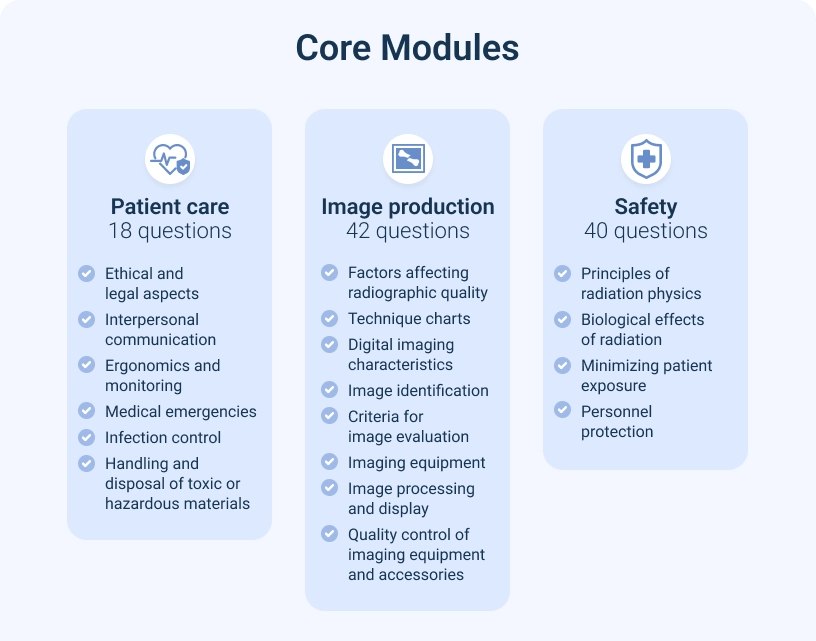
Procedure Modules
License applicants also take one or more procedure modules of this exam. Each module corresponds to a specific area of the body. The ones they take can vary depending on the type of license they wish to pursue or the licensing requirements as set forth by their state.
Each procedure module consists of 20 or 25 scored questions and five additional unscored questions. Module options (and their number of scored questions) include:
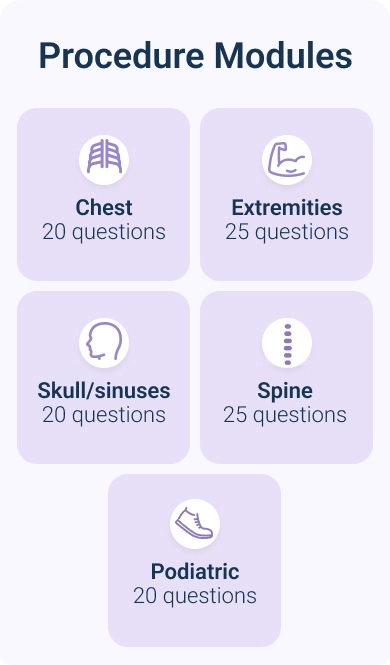
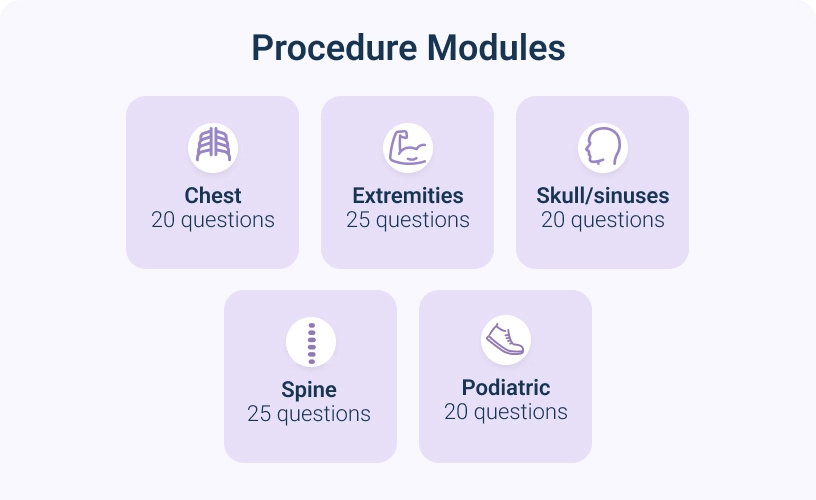
Examination questions are highly focused on patient positioning with a medium emphasis on anatomy and evaluation of displayed anatomical structures. There is less or lower emphasis on procedure adaptation, equipment, and accessories, with no equipment or accessories questions in the podiatric module.
Applicants taking the chest, skull/sinuses, and podiatric modules are given 25 minutes to complete each of these exam sections. Those taking the extremities and spine modules have 30 minutes to complete each.
Limited Scope Radiography License Exam Basics
To apply for the ARRT’s Limited Scope of Practice in Radiography exam, candidates must complete an application, pay any required fees, and supply any necessary documentation.5
The cost for the Limited Scope of Practice in Radiography exam is $150.6 Pearson VUE administers the exam and applicants are typically given a 90-day window for scheduling and completing the test, though up to three extensions may be requested (some restrictions apply).
ARRT supplies a 2024 Handbook for State Candidates that applicants can review for more detailed information. It also provides links to individual states’ licensing agencies, and this list can be filtered to only provide information specific to limited x-ray machine operator regulations.
Empower Your Team with Limited Scope Radiography Training
Nasium Training offers a Limited Scope Radiography course designed to prepare medical assistants and other healthcare professionals with the training needed to perform basic X-ray functions. This 14-week course provides training in areas such as:
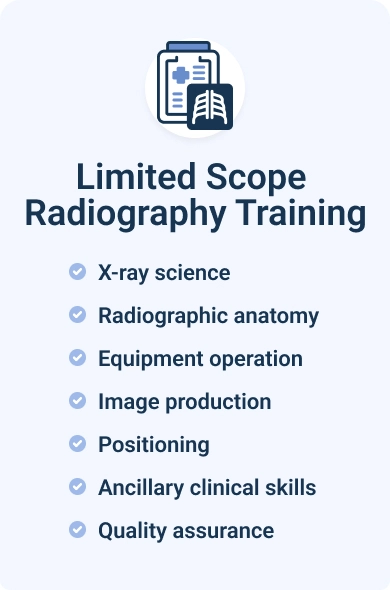
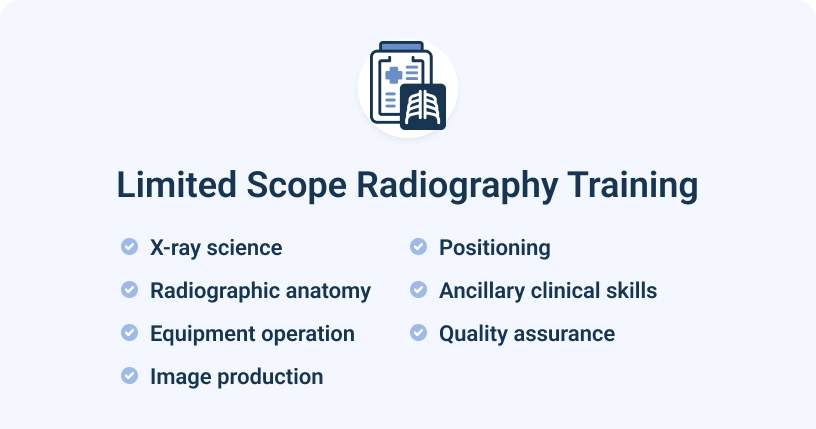
Nasium Training’s Limited Scope Radiography course also includes study guide materials to better prepare learners to take the ARRT Limited Scope of Practice in Radiography exam.
To learn more about how we can help you upskill and reskill your healthcare workers, contact us today. We look forward to partnering with you to build a stronger, more resilient healthcare team!
Training series hours estimates are based on state requirements and other factors. This course may be referred to as Basic X-Ray Machine Operator or Basic X-Ray Radiology Machine Operator in some states.
1 Ayers A. Who Can Take X-Rays in an Urgent Care Center? The Journal of Urgent Care Medicine. https://www.jucm.com/wp-content/uploads/2023/02/2022-17223-25-Health-Law.pdf
2 Pursley Dooling J. Cross-Functional Teams: Collaborate and Listen. AHIMA. https://www.justassociates.com/application/files/3815/2224/2798/Cross-Functional_Teams__Collaborate_and_Listen.pdf
3 ARRT. State Licensing. https://www.arrt.org/pages/about-the-profession/state-licensing
4 ARRT. Limited Scope of Practice in Radiography. https://assets-us-01.kc-usercontent.com/406ac8c6-58e8-00b3-e3c1-0c312965deb2/7deaf7d9-9770-427b-b9c6-3e6a555020cc/LIM_CSTI_2023.pdf
5 ARRT. 2024 Handbook for State Candidates. https://assets-us-01.kc-usercontent.com/406ac8c6-58e8-00b3-e3c1-0c312965deb2/fe42db6c-b450-4ead-a9d2-fc20305801cc/state-handbook.pdf
6 ARRT. Handbook & Fees. https://state.arrt.org/pages/handbooks-fees
